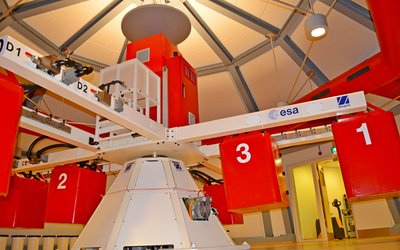Meet the teams: GRAVARC
Three teams of university students were selected to develop and perform their hypergravity experiments during ESA's ‘Spin Your Thesis!’ 2012 campaign. Here is an introduction to the Czech team.
![]()
![]()
Gliding arc under varying hypergravity: plasma diagnostics and deposition of carbon nanostructures
![]()
![]()
| University | Masaryk University |
| Endorsing professor |
Vit Kudrle Masaryk University |
| ELGRA mentor |
G.M.W.Kroesen Technische Universiteit Eindhoven |
| Team | Jiri Sperka, Pavel Soucek |
The GRAVARC team is composed of two PhD students from Masaryk University (Czech Republic). They investigated the behaviour of gliding arc discharges in a methane-rich atmosphere in conditions of hypergravity and the properties of the solid products of the plasma-chemical reactions involved.
A gliding arc is an electrical discharge which is formed between two or more divergent electrodes with a gas between them. The electrical discharge is formed in the gas, at the smallest gap between these electrodes. The discharge then spreads as it glides along the electrode edges with an increasingly large gap until it dissipates when it clears the electrodes. The team studied the effects of gravity on the shape, intensity, colour and emission spectra of the discharge.
The dynamics of the gliding arc plasma discharge are partially governed by hot gas buoyancy. Since the strength of the forces exerted by the buoyancy effect varies with gravity, the team expected to observe dynamics that depend on the level of gravity.
A gliding arc discharge was created inside a gondola from the Large Diameter Centrifuge (LDC). By using a high speed video camera and a mirror, the team obtained high speed video of the plasma dynamics from two angles. An optical spectrometer and a microphone were used to record the visual and audio spectra of the gliding arc plasma discharge.
The team also studied the properties of the resulting solid products of the plasma-chemical reactions involved. Similar plasma-related techniques, such as Plasma Enhanced Chemical Vapour Deposition (PECVD) or Physical Vapour Deposition (PVD) are already widely used in the synthetic production of carbon nanomaterials.
Carbon nanotubes, nanodiamonds, graphene and fullerenes are among the solid products expected from the GRAVARC team’s experiment. These advanced materials – which have already found uses in composites, electronic devices, sensors, biocompatible devices, coatings, tribology, and many other applications – constitute a new class of materials with several advantageous properties. Previous experiments have shown that hypergravity alters the process of deposition and properties of the resulting solid materials: nucleation site density, deposition rate, grain size, crystal morphology and uniformity are all affected by changing the gravity level.
To facilitate the creation of carbon nanostructures, a gas containing methane flowed through the experimental chamber during the discharge. Solid products of the plasma-chemical reactions were collected on samples introduced into the gondola as well as in the filter of the exiting gas mixture. The team used some measurement facilities at ESTEC to analyse the microstructure of the deposited material throughout their campaign.
Read the final experiment report here.






